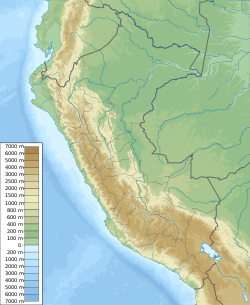
Back جبل هوايناپوتينا ARZ Уайнапуціна Byelorussian Уайнапутына BE-X-OLD Huaynaputina BJN Cerro Huaynaputina CEB Huaynaputina Czech Huaynaputina Danish Huaynaputina German Ουαϊναπουτίνα Greek Huaynaputina Spanish
It has been suggested that this article be split into a new article titled 1600 eruption of Huaynaputina. (Discuss) (February 2025) |
| Huaynaputina | |
|---|---|
Location in Peru | |
| Highest point | |
| Elevation | ≈4,850 m (15,910 ft)[1] |
| Listing | List of volcanoes in Peru |
| Coordinates | 16°36′56″S 70°50′59″W / 16.61556°S 70.84972°W[1] |
| Naming | |
| Language of name | Quechua |
| Geography | |
| Location | Peru |
| Parent range | Andes |
| Geology | |
| Mountain type | Stratovolcano |
| Volcanic arc/belt | Central Volcanic Zone |
| Last eruption | February to March 1600 |
Huaynaputina (/ˌwaɪnəpʊˈtiːnə/ WY-nə-puu-TEE-nə; Spanish: [wajnapuˈtina]) is a volcano in a volcanic high plateau in southern Peru. Lying in the Central Volcanic Zone of the Andes, it was formed by the subduction of the oceanic Nazca Plate under the continental South American Plate. Huaynaputina is a large volcanic crater, which lacks an identifiable mountain profile, with an outer stratovolcano and three younger volcanic vents within an amphitheatre-shaped structure that is either a former caldera or a remnant of glacial erosion. The volcano has erupted dacitic magma.
Huaynaputina has erupted several times during the Holocene,[a] including on 19 February 1600 – the largest recorded eruption ever witnessed in South America – which continued with a series of events into March. Witnessed by people in the city of Arequipa, it killed at least 1,000–1,500 people in the region, wiped out vegetation, buried the surrounding area with 2 metres (7 ft) of volcanic rock, and damaged infrastructure and economic resources. The eruption had a significant impact on Earth's climate, causing a volcanic winter: temperatures in the Northern Hemisphere decreased; cold waves hit parts of Europe, Asia, and the Americas; and the climate disruption may have played a role in the onset of the Little Ice Age. Floods, famines, and social upheavals resulted, including a probable link with the Russian famine of 1601–1603 and Time of Troubles. This eruption has been computed to measure 6 on the Volcanic Explosivity Index (VEI).
The volcano has not erupted since 1600. There are fumaroles[b] in the amphitheatre-shaped structure, and hot springs occur in the region, some of which have been associated with Huaynaputina. The volcano lies in a remote region where there is little human activity, but about 30,000 people live in the immediately surrounding area, and another one million in the Arequipa metropolitan area. If an eruption similar to the 1600 event were to occur, it would quite likely lead to a high death toll and cause substantial socioeconomic disruption. The Peruvian Geophysical Institute announced in 2017 that Huaynaputina would be monitored by the Southern Volcanological Observatory, and seismic observation began in 2019.
Cite error: There are <ref group=lower-alpha> tags or {{efn}} templates on this page, but the references will not show without a {{reflist|group=lower-alpha}} template or {{notelist}} template (see the help page).
© MMXXIII Rich X Search. We shall prevail. All rights reserved. Rich X Search
